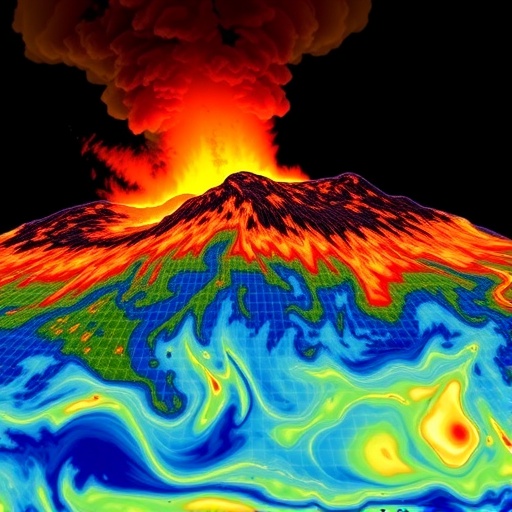In a groundbreaking new study published in Nature Communications, researchers have unveiled how volcanic eruptions significantly disrupt the complex teleconnections between the El Niño-Southern Oscillation (ENSO) and summer land temperatures across the globe. This revelation not only alters our understanding of climate variability following volcanic events but also highlights the intricate interplay between atmospheric phenomena and terrestrial climate responses. The research provides unprecedented insights into how volcanic aerosols interfere with ENSO’s far-reaching influence, with broad implications for climate prediction and risk management.
ENSO stands as one of the most influential drivers of interannual climate variability worldwide, modulating weather patterns, precipitation, and temperature anomalies across diverse geographic regions. Its teleconnections—climatic linkages that transmit ENSO-induced signals to remote areas—are fundamental to how scientists predict summer temperatures on continental scales. Volcanic eruptions, by injecting large volumes of aerosols into the stratosphere, can precipitate sudden and pronounced cooling at the Earth’s surface. However, until now, how these eruptions meddle with ENSO’s teleconnections remained poorly understood.
The researchers harnessed a combination of climate model simulations and observational datasets, meticulously analyzing the aftermath of major volcanic events over recent decades. What emerges from the data is a picture of dynamic disruption: post-eruption periods showcase a breakdown or substantial weakening of the traditional ENSO teleconnections with summer land temperatures. These findings underscore a fundamental shift in climate system behavior under volcanic forcing, altering the “communication” between the tropical Pacific—where ENSO originates—and remote continental climates.
At the core of the disruption is the complex interplay between volcanic aerosols and atmospheric circulation. Volcanic particles reflect and absorb solar radiation, resulting in surface cooling but also modifying temperature gradients and pressure patterns globally. These aerosol-induced changes perturb the Walker circulation, a critical component of ENSO dynamics, and consequently reshape patterns of atmospheric convection. The result is a decoupling of ENSO’s usual teleconnection pathways, making it harder for the ENSO signal to propagate effectively to terrestrial regions.
One of the most striking impacts revealed in this study relates to North America and Eurasia, where summer temperatures are strongly influenced by ENSO under normal conditions. After significant volcanic eruptions, these regions experience suppressed teleconnection signals, leading to anomalously heterogeneous temperature responses that defy typical ENSO patterns. This spatial inconsistency poses new challenges for seasonal forecasting and climate adaptation strategies, as it undermines the reliability of ENSO as a predictor for summer trends.
The methodology employed combined cutting-edge climate model experiments that incorporated realistic volcanic aerosol forcings and advanced statistical techniques to isolate ENSO signals in temperature data. By contrasting eruptive versus non-eruptive periods, the team successfully quantified the attenuation in teleconnection strength. Moreover, they explored the temporal evolution of these disruptions, revealing that the effects are most pronounced in the first one or two years following an eruption, with gradual recovery thereafter.
This research stitches together threads from volcanology, atmospheric physics, and climate dynamics to build a comprehensive narrative. It challenges the prevailing assumption that volcanic cooling and ENSO impacts operate independently, instead suggesting a more nuanced framework where volcanic eruptions actively reshape ENSO’s global climatic footprint. This reframing has significant implications for improving climate model projections, particularly in forecasting climate variability in the years following volcanic activity.
The consequences of these findings ripple beyond academic curiosity. Reliable predictions of summer temperatures are vital for agriculture, water resource management, and urban planning—sectors that depend heavily on understanding teleconnected climate patterns. The disruption of ENSO teleconnections adds an unpredictable factor to these systems, underscoring the necessity of integrating volcanic forcing effects into climate risk assessments and early warning systems.
Moreover, the study enhances our grasp of the feedback loops within the Earth system. By modulating the teleconnections, volcanic eruptions indirectly influence ocean-atmosphere interactions and global energy balance. These interactions are crucial in mediating the climate’s response to both natural and anthropogenic forcings, pointing to the interconnectedness of Earth’s climate subsystems and the sensitivity of these linkages to external disturbances.
The findings also prompt a reevaluation of past climate events, especially those periods marked by strong volcanic activity coinciding with ENSO phases. Historical climate reconstructions may need revision to account for volcanic-induced teleconnection disruptions, potentially altering interpretations of temperature anomalies recorded in ice cores, tree rings, and sediment layers.
Beyond understanding climate mechanisms, this research opens new avenues for improving climate resilience. Integrating these insights into climate services can help policymakers and communities better anticipate variability and extremes, particularly in the vulnerable post-volcanic era. Tailored adaptation plans can mitigate the socio-economic risks posed by unexpected climate behavior driven by such disruptions.
Critically, the study underscores the importance of enhanced monitoring and modeling capabilities. Better observational networks for volcanic aerosols and expanded high-resolution climate models will refine future studies. As volcanic activity remains an unpredictable but impactful climate agent, sustained research into its interactions with oscillatory systems like ENSO is essential.
The culmination of this work marks a significant milestone in unraveling the intricate fabric of climate teleconnections. Zhang, Li, Xie, and colleagues have provided compelling evidence that volcanic eruptions induce a profound yet transient fracture in ENSO’s link to summer land temperatures, reshaping our understanding of climate variability in a warming world punctuated by episodic natural disturbances.
In sum, this study enriches climate science by elucidating the mechanisms behind volcanic disruption of ENSO teleconnections. It paints a clearer picture of the vulnerabilities and complexities inherent in Earth’s climate system and lays the groundwork for more robust forecasts and adaptive strategies. As researchers continue to decode the climate’s nuanced responses to volcanic forcing, society stands to benefit from more informed, resilient approaches to the climate challenges ahead.
Subject of Research: The disruption of ENSO teleconnections with land summer temperature by volcanic eruptions.
Article Title: Volcanic eruptions disrupt ENSO teleconnections with land summer temperature.
Article References:
Zhang, X., Li, J., Xie, SP. et al. Volcanic eruptions disrupt ENSO teleconnections with land summer temperature. Nat Commun 16, 9882 (2025). https://doi.org/10.1038/s41467-025-64879-w
Image Credits: AI Generated




